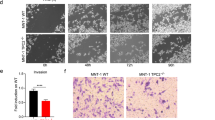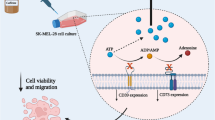Abstract
Melanoma is the most dangerous form of skin cancer occurring in Caucasians with rising incidence. They are remarkably resistant to conventional anti-tumour therapies like chemotherapy and radiotherapy. Therefore, new treatment strategies are urgently needed. Anti-tumour effects of phytochemicals such as allyl isothiocyanate or cinnamaldehyde have been demonstrated in various melanoma models in vitro and in vivo. Considering their high potency as transient receptor potential A1 (TRPA1)-activating compounds, we examined the functional expression of TRPA1 channels in different melanoma cell lines as well as in non-malignantly transformed primary melanocytes. The presence of TRPA1 transcripts could be detected in most of the melanoma cell lines. Furthermore, single-cell calcium imaging and patch clamp electrophysiology confirmed the presence of functional TRPA1 channels in those cell lines. Proliferation assays revealed that allyl isothiocyanate and cinnamaldehyde clearly reduce the proliferation of melanoma cells, but this effect is independent of an activation of TRPA1 channels, making it unlikely that ionic currents through TRPA1 are responsible for the anti-tumour effects of mustard oil and cinnamaldehyde.






Similar content being viewed by others
References
Allen DH, Lepple-Wienhues A, Cahalan MD (1997) Ion channel phenotype of melanoma cell lines. J Membr Biol 155:27–34
Artym VV, Petty HR (2002) Molecular proximity of Kv1.3 voltage-gated potassium channels and beta(1)-integrins on the plasma membrane of melanoma cells: effects of cell adherence and channel blockers. J Gen Physiol 120:29–37
Atoyan R, Shander D, Botchkareva NV (2009) Non-neuronal expression of transient receptor potential type A1 (TRPA1) in human skin. J Invest Dermatol 129:2312–2315
Bandell M, Story GM, Hwang SW, Viswanath V, Eid SR, Petrus MJ, Earley TJ, Patapoutian A (2004) Noxious cold ion channel TRPA1 is activated by pungent compounds and bradykinin. Neuron 41:849–857
Bautista DM, Movahed P, Hinman A, Axelsson HE, Sterner O, Hogestatt ED, Julius D, Jordt SE, Zygmunt PM (2005) Pungent products from garlic activate the sensory ion channel TRPA1. Proc Natl Acad Sci U S A 102:12248–12252
Bautista DM, Jordt SE, Nikai T, Tsuruda PR, Read AJ, Poblete J, Yamoah EN, Basbaum AI, Julius D (2006) TRPA1 mediates the inflammatory actions of environmental irritants and proalgesic agents. Cell 124:1269–1282
Cabello CM, Bair WB III, Lamore SD, Ley S, Bause AS, Azimian S, Wondrak GT (2009) The cinnamon-derived Michael acceptor cinnamic aldehyde impairs melanoma cell proliferation, invasiveness, and tumor growth. Free Radic Biol Med 46:220–231
Chantome A, Girault A, Potier M, Collin C, Vaudin P, Pages JC, Vandier C, Joulin V (2009) KCa2.3 channel-dependent hyperpolarization increases melanoma cell motility. Exp Cell Res 315:3620–3630
Chen J, Zhang XF, Kort ME, Huth JR, Sun C, Miesbauer LJ, Cassar SC, Neelands T, Scott VE, Moreland RB, Reilly RM, Hajduk PJ, Kym PR, Hutchins CW, Faltynek CR (2008) Molecular Determinants of species-specific activation or blockade of TRPA1 channels. J Neurosci 28:5063–5071
Deeds J, Cronin F, Duncan LM (2000) Patterns of melastatin mRNA expression in melanocytic tumors. Hum Pathol 31:1346–1356
Duessel S, Heuertz RM, Ezekiel UR (2008) Growth inhibition of human colon cancer cells by plant compounds. Clin Lab Sci 21:151–157
Duncan LM, Deeds J, Cronin FE, Donovan M, Sober AJ, Kauffman M, McCarthy JJ (2001) Melastatin expression and prognosis in cutaneous malignant melanoma. J Clin Oncol 19:568–576
Eggermont AM, Testori A, Marsden J, Hersey P, Quirt I, Petrella T, Gogas H, MacKie RM, Hauschild A (2009) Utility of adjuvant systemic therapy in melanoma. Ann Oncol 20(Suppl 6):vi30–vi34
Erickson LA, Letts GA, Shah SM, Shackelton JB, Duncan LM (2009) TRPM1 (Melastatin-1/MLSN1) mRNA expression in Spitz nevi and nodular melanomas. Mod Pathol 22:969–976
Fuke Y, Shinoda S, Nagata I, Sawaki S, Murata M, Ryoyama K, Koizumi K, Saiki I, Nomura T (2006) Preventive effect of oral administration of 6-(methylsulfinyl)hexyl isothiocyanate derived from wasabi (Wasabia japonica Matsum) against pulmonary metastasis of B16-BL6 mouse melanoma cells. Cancer Detect Prev 30:174–179
Giard DJ, Aaronson SA, Todaro GJ, Arnstein P, Kersey JH, Dosik H, Parks WP (1973) In vitro cultivation of human tumors: establishment of cell lines derived from a series of solid tumors. J Natl Cancer Inst 51:1417–1423
Gilhooly EM, Morse-Gaudio M, Bianchi L, Reinhart L, Rose DP, Connolly JM, Reed JA, Albino AP (2001) Loss of expression of protein kinase c beta is a common phenomenon in human malignant melanoma: a result of transformation or differentiation? Melanoma Res 11:355–369
Gkika D, Flourakis M, Lemonnier L, Prevarskaya N (2010) PSA reduces prostate cancer cell motility by stimulating TRPM8 activity and plasma membrane expression. Oncogene 29:4611–4616
Hammock L, Cohen C, Carlson G, Murray D, Ross JS, Sheehan C, Nazir TM, Carlson JA (2006) Chromogenic in situ hybridization analysis of melastatin mRNA expression in melanomas from American Joint Committee on Cancer Stage I and II patients with recurrent melanoma. J Cutan Pathol 33:599–607
Henshall SM, Afar DE, Hiller J, Horvath LG, Quinn DI, Rasiah KK, Gish K, Willhite D, Kench JG, Gardiner-Garden M, Stricker PD, Scher HI, Grygiel JJ, Agus DB, Mack DH, Sutherland RL (2003) Survival analysis of genome-wide gene expression profiles of prostate cancers identifies new prognostic targets of disease relapse. Cancer Res 63:4196–4203
Hwang ES, Kim GH (2009) Allyl isothiocyanate influences cell adhesion, migration and metalloproteinase gene expression in SK-Hep1 cells. Exp Biol Med (Maywood ) 234:105–111
Jordt SE, Bautista DM, Chuang HH, McKemy DD, Zygmunt PM, Hogestatt ED, Meng ID, Julius D (2004) Mustard oils and cannabinoids excite sensory nerve fibres through the TRP channel ANKTM1. Nature 427:260–265
Karashima Y, Damann N, Prenen J, Talavera K, Segal A, Voets T, Nilius B (2007) Bimodal action of menthol on the transient receptor potential channel TRPA1. J Neurosci 27:9874–9884
Koppikar SJ, Choudhari AS, Suryavanshi SA, Kumari S, Chattopadhyay S, Kaul-Ghanekar R (2010) Aqueous cinnamon extract (ACE-c) From the bark of Cinnamomum cassia causes apoptosis in human cervical cancer cell line (SiHa) through loss of mitochondrial membrane potential. BMC Cancer 10:210
Lenz JC, Reusch HP, Albrecht N, Schultz G, Schaefer M (2002) Ca2 + -controlled competitive diacylglycerol binding of protein kinase C isoenzymes in living cells. J Cell Biol 159:291–302
Musk SR, Johnson IT (1993) Allyl isothiocyanate is selectively toxic to transformed cells of the human colorectal tumour line HT29. Carcinogenesis 14:2079–2083
Peebles PT, Trisch T, Papageorge AG (1978) Isolation of four unusual pediatric solid tumor cell lines. Pediatr Res 12(4):485
Peier AM, Moqrich A, Hergarden AC, Reeve AJ, Andersson DA, Story GM, Earley TJ, Dragoni I, McIntyre P, Bevan S, Patapoutian A (2002) A TRP channel that senses cold stimuli and menthol. Cell 108:705–715
Sharma AK, Sharma A, Desai D, Madhunapantula SV, Huh SJ, Robertson GP, Amin S (2008) Synthesis and anticancer activity comparison of phenylalkyl isoselenocyanates with corresponding naturally occurring and synthetic isothiocyanates. J Med Chem 51:7820–7826
Story GM, Peier AM, Reeve AJ, Eid SR, Mosbacher J, Hricik TR, Earley TJ, Hergarden AC, Andersson DA, Hwang SW, McIntyre P, Jegla T, Bevan S, Patapoutian A (2003) ANKTM1, a TRP-like channel expressed in nociceptive neurons, is activated by cold temperatures. Cell 112:819–829
Tsavaler L, Shapero MH, Morkowski S, Laus R (2001) Trp-p8, a novel prostate-specific gene, is up-regulated in prostate cancer and other malignancies and shares high homology with transient receptor potential calcium channel proteins. Cancer Res 61:3760–3769
Xiao D, Srivastava SK, Lew KL, Zeng Y, Hershberger P, Johnson CS, Trump DL, Singh SV (2003) Allyl isothiocyanate, a constituent of cruciferous vegetables, inhibits proliferation of human prostate cancer cells by causing G2/M arrest and inducing apoptosis. Carcinogenesis 24:891–897
Yamamura H, Ugawa S, Ueda T, Morita A, Shimada S (2008) TRPM8 activation suppresses cellular viability in human melanoma. Am J Physiol Cell Physiol 295:C296–C301
Zhang Y (2010) Allyl isothiocyanate as a cancer chemopreventive phytochemical. Mol Nutr Food Res 54:127–135
Zhang L, Barritt GJ (2004) Evidence that TRPM8 is an androgen-dependent Ca2+ channel required for the survival of prostate cancer cells. Cancer Res 64:8365–73
Acknowledgments
We thank Nicole Urban for excellent technical assistance. This work was supported by the Deutsche Forschungsgemeinschaft (HI 829/2-1 and GRK1097).
Author information
Authors and Affiliations
Corresponding author
Rights and permissions
About this article
Cite this article
Oehler, B., Scholze, A., Schaefer, M. et al. TRPA1 is functionally expressed in melanoma cells but is not critical for impaired proliferation caused by allyl isothiocyanate or cinnamaldehyde. Naunyn-Schmiedeberg's Arch Pharmacol 385, 555–563 (2012). https://doi.org/10.1007/s00210-012-0747-x
Received:
Accepted:
Published:
Issue Date:
DOI: https://doi.org/10.1007/s00210-012-0747-x




